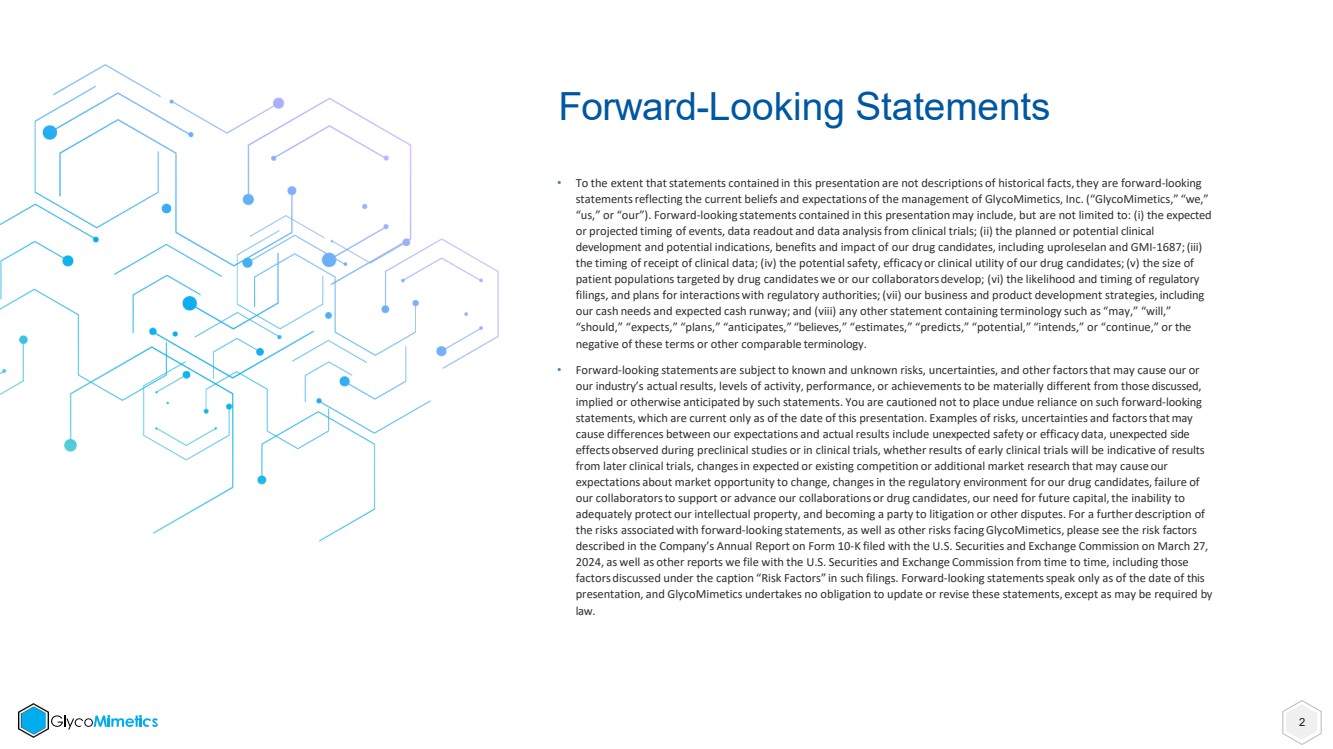
| 2
Forward-Looking Statements
• To the extent thatstatements contained in this presentation are not descriptions of historical facts,they are forward-looking
statementsreflecting the current beliefs and expectations of the management of GlycoMimetics, Inc. (“GlycoMimetics,” “we,”
“us,” or “our”). Forward-looking statements contained in this presentationmay include, but are not limited to: (i) the expected
or projected timing of events, data readout and data analysisfrom clinical trials; (ii) the planned or potential clinical
development and potential indications, benefits and impact of our drug candidates, including uproleselan and GMI-1687;(iii)
the timing of receipt of clinical data; (iv) the potentialsafety, efficacy or clinical utility of our drug candidates;(v) the size of
patient populations targeted by drug candidateswe or our collaboratorsdevelop; (vi) the likelihood and timing of regulatory
filings, and plans for interactionswith regulatory authorities; (vii) our business and product development strategies, including
our cash needs and expected cash runway; and (viii) any otherstatement containing terminology such as “may,” “will,”
“should,” “expects,” “plans,” “anticipates,” “believes,” “estimates,” “predicts,” “potential,” “intends,” or “continue,” or the
negative of these terms or other comparable terminology.
• Forward-looking statements are subject to known and unknown risks, uncertainties, and other factorsthat may cause our or
our industry’s actualresults, levels of activity, performance, or achievements to be materially different from those discussed,
implied or otherwise anticipated by such statements. You are cautioned not to place undue reliance on such forward-looking
statements, which are current only as of the date of this presentation. Examples of risks, uncertainties and factorsthatmay
cause differences between our expectations and actual results include unexpected safety or efficacy data, unexpected side
effectsobserved during preclinical studies or in clinical trials, whether results of early clinical trials will be indicative of results
from later clinical trials, changesin expected or existing competition or additional market research that may cause our
expectations about market opportunity to change, changes in the regulatory environment for our drug candidates, failure of
our collaboratorsto support or advance our collaborations or drug candidates, our need for future capital,the inability to
adequately protect our intellectual property, and becoming a party to litigation or other disputes. For a further description of
the risks associatedwith forward-looking statements, as well as other risks facingGlycoMimetics, please see the risk factors
described in the Company’s Annual Report on Form 10-K filed with the U.S. Securities and Exchange Commission on March 27,
2024, as well as other reports we file with the U.S. Securities and Exchange Commission from time to time, including those
factorsdiscussed under the caption “Risk Factors” in such filings. Forward-looking statementsspeak only as of the date of this
presentation, and GlycoMimetics undertakes no obligation to update or revise these statements, except as may be required by
law. |